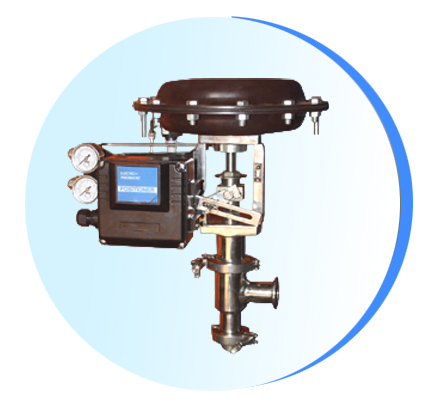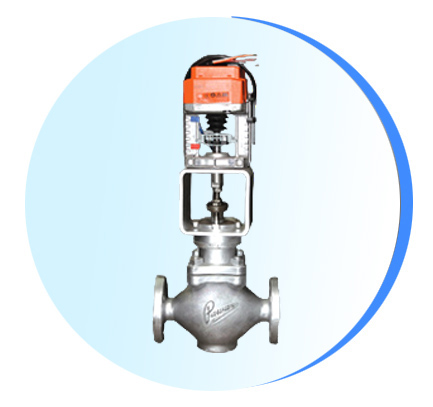
Control valves are essential components used in industrial process control systems to regulate the flow, pressure, temperature, and level of fluids and gases. These valves play a critical role in maintaining operational efficiency, precision, and safety across various industries. In this comprehensive guide, we will explore the working principles, types, applications, and maintenance considerations of control valves. Whether you are an engineer, technician, or someone interested in process control, this article will provide valuable insights into the importance and functionality of control valves in industrial settings.
Working Principles of Control Valves -
Control valves operate based on the principle of modulating the flow of fluid or gas to achieve the desired process conditions. They consist of a valve body, actuator, positioned, and control signal source. The actuator receives a control signal from a controller or automation system, which adjusts the valve position based on the desired set point.
When the control signal is received, the actuator moves the valve stem, which opens or closes the valve, thereby modulating the flow. The positioned ensures accurate valve positioning by comparing the actual valve position with the desired position and making necessary adjustments.
Control valves may incorporate various valve designs, including globe, butterfly, ball, and plug valves. They can be equipped with different types of control elements, such as throttling plugs, discs, or balls, to achieve precise control over flow, pressure, temperature, or level.

Types of Control Valves -
Control valves are available in several types, each designed to meet specific control requirements. Some common types include:
a) Globe valves : Globe valves are widely used in process control due to their excellent throttling capabilities. They provide precise control over flow by adjusting the position of a disc or plug against a seat.
b) Butterfly valves : Butterfly valves offer a compact design and quick actuation. They are suitable for applications requiring large flow capacities and fast response times.
c) Ball valves : Ball valves provide excellent shutoff capabilities and are commonly used in applications where quick on/off control is required. They offer low-friction operation and can handle high-pressure applications.
d) Plug valves : Plug valves feature a cylindrical or tapered plug that rotates within the valve body to control flow. They are suitable for applications requiring tight shutoff and precise control.
e) Diaphragm valves : Diaphragm valves use a flexible diaphragm to regulate flow. They are commonly used in applications where contamination-free and sanitary conditions are essential.
f) Pinch valves : Pinch valves use a flexible tube or sleeve that is pinched or compressed to control flow. They are ideal for handling abrasive or corrosive fluids.
Applications of Control Valves -
Control valves find applications in a wide range of industries where precise control of process parameters is critical. Some common applications include:
a) Oil and gas industry : Control valves are utilized in upstream, midstream, and downstream operations in the oil and gas sector. They regulate the flow of oil, gas, and various hydrocarbon products, ensuring efficient and safe operations.
b) Chemical processing : Control valves are crucial in chemical plants for controlling the flow, pressure, and temperature of various chemicals during manufacturing processes. They play a vital role in maintaining product quality and process efficiency.
c) Power generation : Control valves are integral components in power plants, including thermal, nuclear, and renewable energy facilities. They regulate steam, gas, and cooling water flow, contributing to the safe and efficient operation of power generation systems.
d) Water and wastewater treatment : Control valves are essential in water and wastewater treatment plants to control the flow, pressure, and level of liquids during treatment processes. They ensure optimal process efficiency and help maintain water quality standards.
e) Food and beverage industry : Control valves are used in food processing, brewing, and beverage production, where precise control of flow and temperature is crucial for maintaining product consistency and quality.
f) Pharmaceutical industry : Control valves play a vital role in pharmaceutical manufacturing processes, regulating the flow of liquids and gases during drug formulation, filtration, and purification. They ensure accurate dosing and maintain process integrity.
g) HVAC systems : Control valves are employed in heating, ventilation, and air conditioning systems to regulate the flow of air, water, or refrigerant. They help maintain desired temperature, humidity, and comfort levels in commercial and residential buildings.
Maintenance Considerations for Control Valves -
Proper maintenance of control valves is essential to ensure their optimal performance and longevity. Here are some important maintenance considerations:
a) Regular inspection : Conduct periodic inspections to check for any signs of wear, corrosion, or damage to the valve body, bellows assembly, and other components. Promptly address any issues to maintain optimal performance.
a) Regular inspection : Conduct periodic inspections to check for signs of wear, leaks, or damage to valve components such as seals, stems, and actuators. Replace any worn or damaged parts promptly to prevent potential control issues.
b) Calibration and testing : Regularly calibrate control valves to ensure they are operating within the desired control range. Perform functional testing to verify the valve's response to control signals and adjust as necessary.
c) Lubrication : Proper lubrication of valve stems and moving parts is crucial for smooth operation. Follow the manufacturer's recommendations regarding the type and frequency of lubrication.
d) Cleanliness : Keep control valves clean and free from debris or buildup that can affect their performance. Regularly clean valve internals and ensure the integrity of sealing surfaces.
e) Training and documentation : Ensure that personnel responsible for maintaining control valves receive proper training on maintenance procedures. Keep detailed records of maintenance activities, including inspection dates, repairs, and replacements, to track the valve's performance history
| Design Standard | ASME B16.34 |
| Valve size | 1/2"to 14" (15MM - 350MM) |
| Pressure Rating | 150# to 2500# other standards available on request |
| End connection | Flanged, Screwed, Butt welded, Socket welded, end TC Connection |
| Material | A216 Gr WCB, A351 CF8 (SS304), A351 CF3 (SS 304L), A351 CF8M (SS 316 ), A351 CF3M (SS 316L), Monel, Hastelloy and as per special specifications. |
| Design Temperature | -20°C to 180°C |


